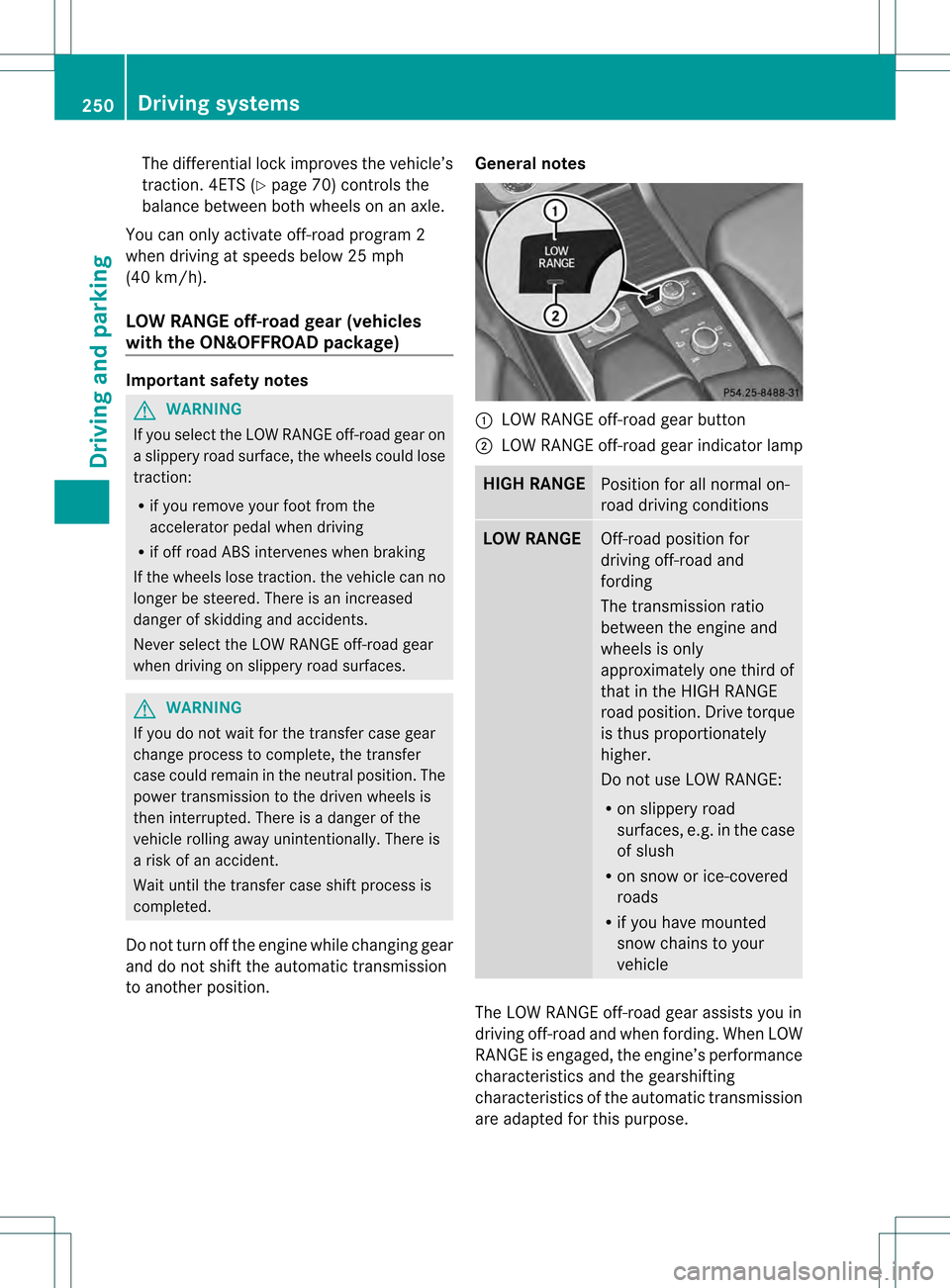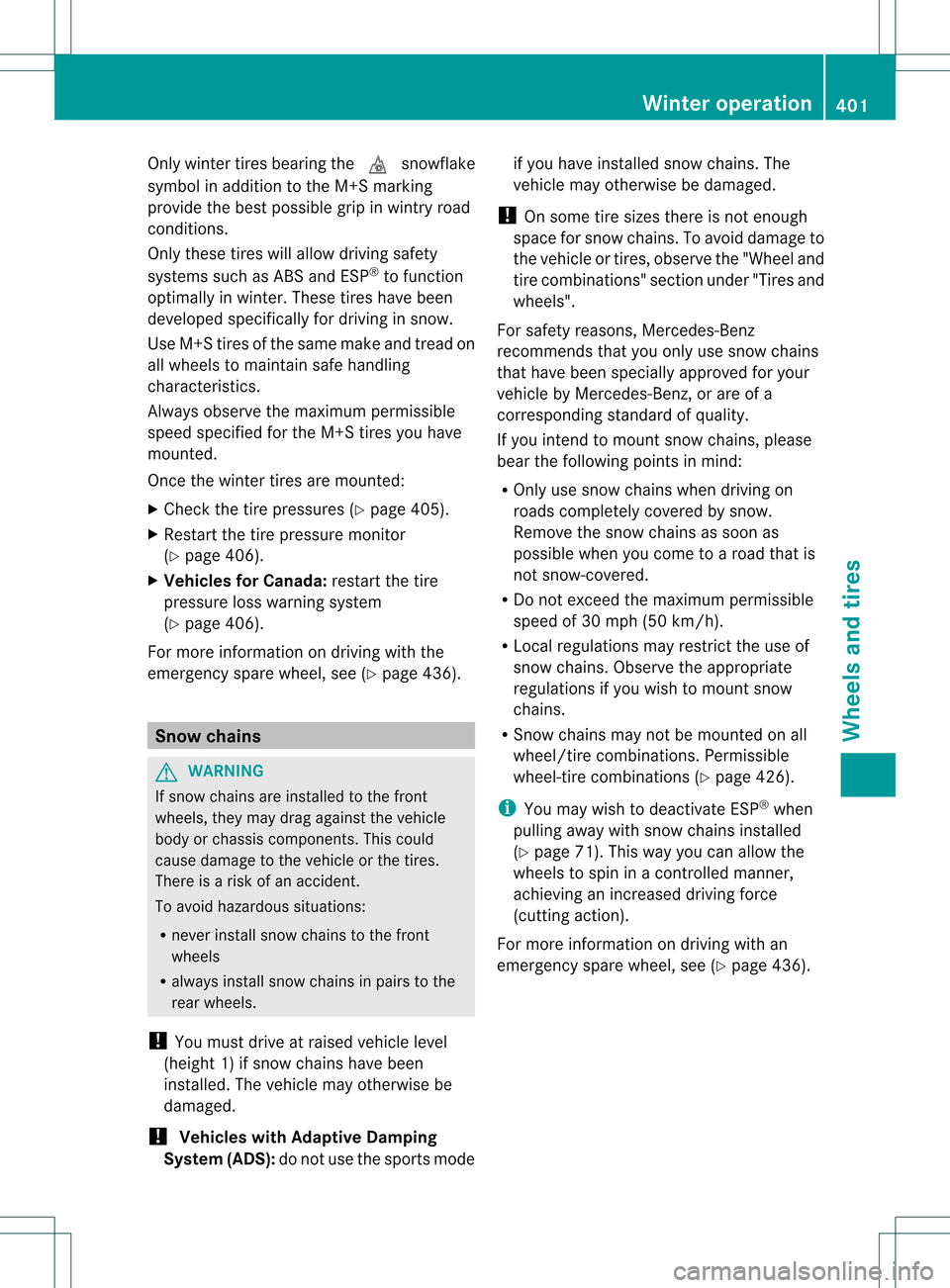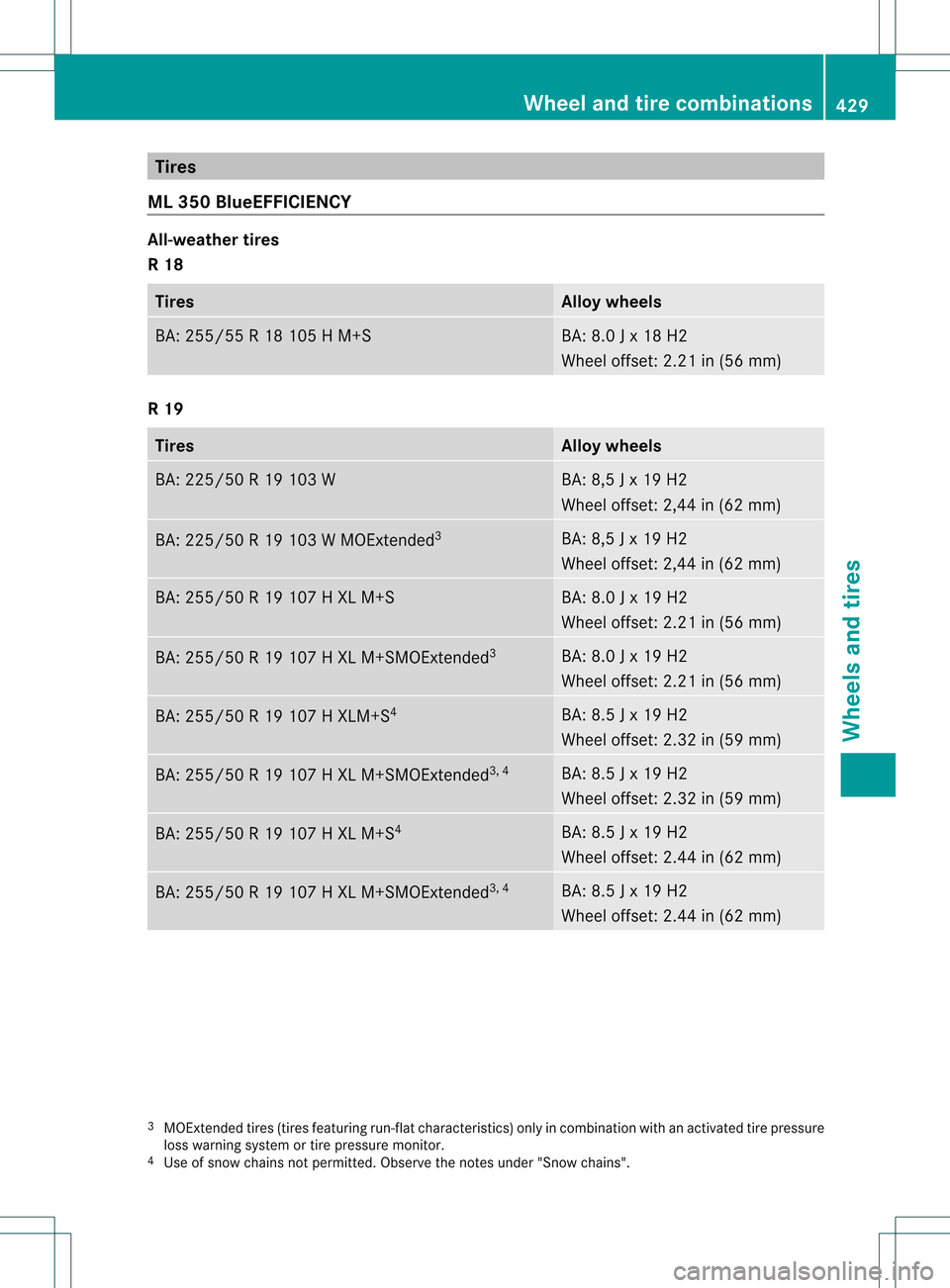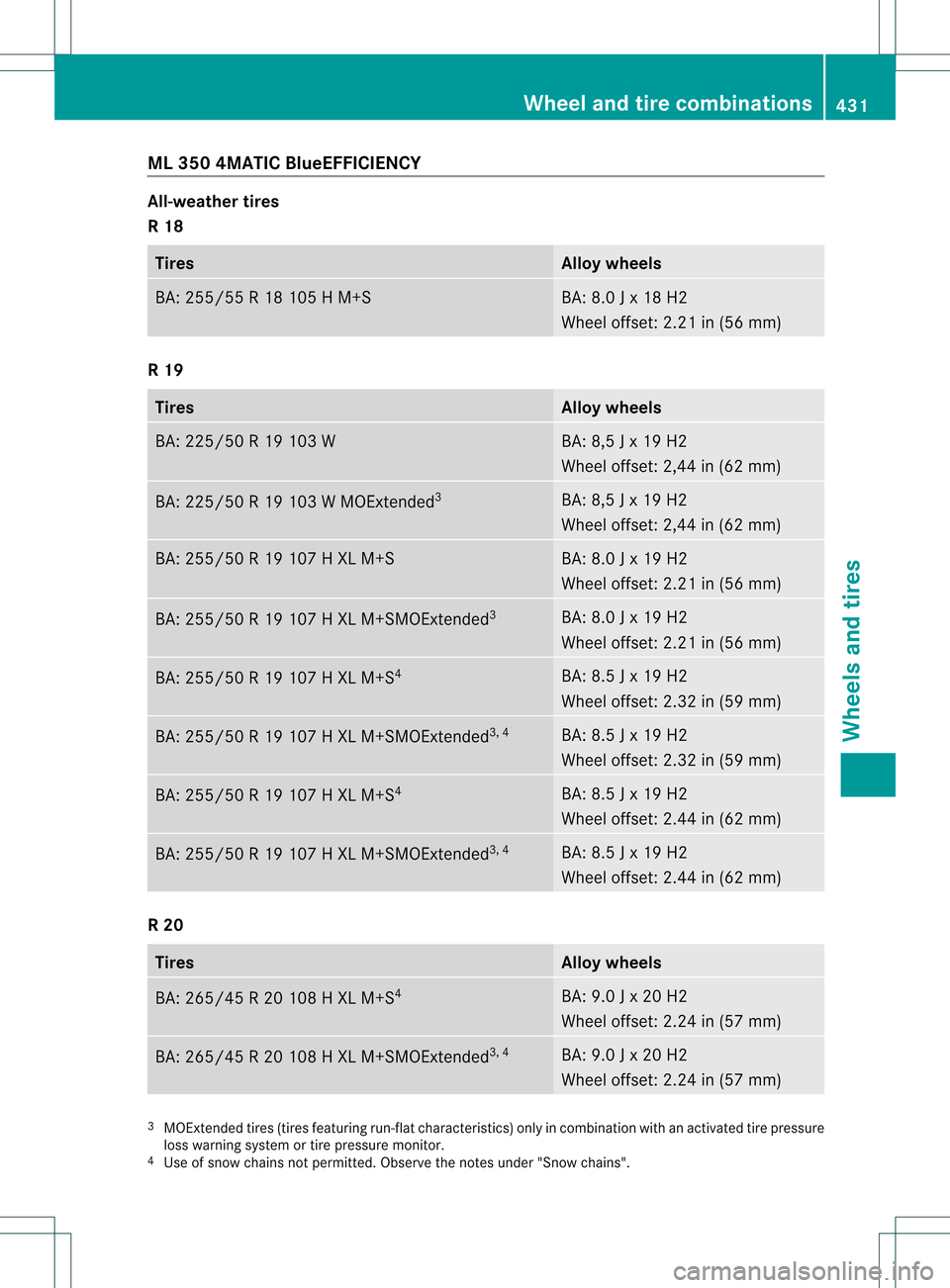2013 MERCEDES-BENZ M-Class snow chains
[x] Cancel search: snow chainsPage 248 of 458

X
Selector wheel 0002 engaged:
briefly press
selector wheel 0002.
Selector wheel 0002extends.
X To select: turn selector wheel 0002until
indicator lamp 0003comes on.
Trailer indicator 001Fappears in the
multifunction display.
R Highway level is set.
R ADS (Adaptive Damping System) adapts
comfortable damping characteristics to
the current operating and driving
conditions.
R The automatic transmission selects the
automatic drive program for a
comfortable driving style that provides
for optimum fuel consumption, changing
gear at optimum points.
R While pulling away, the differential locks
are engaged. Off-road driving systems
4MATIC (permanent four-wheel drive) If you fail to adapt your driving style, 4MATIC
can neither reduce the risk of accident nor
override the laws of physics. 4MATIC cannot
take account of road, weather and traffic
conditions. 4MATIC is only an aid. You are
responsible for the distance to the vehicle in
front, for vehicle speed, for braking in good
time and for staying in your lane.
! Never tow the vehicle with one axle
raised. This may damage the transfer case.
Damage of this sort is not covered by the
Mercedes-Benz Limited Warranty. All
wheels must remain either on the ground
or be fully raised. Observe the instructions
for towing the vehicle with all wheels in full
contact with the ground.
! A function or performance test should
only be carried out on atwo-axle
dynamometer. Before you operate the
vehicle on such a dynamometer, please
consult a qualified workshop .You could otherwise damage the drive train or the
brake system.
4MATIC ensures that all four wheels are
permanently driven. Together with ESP ®
and
4ETS, it improves the traction of your vehicle
whenever a drive wheel spins due to
insufficien tgrip.
i In wintry driving conditions, the maximum
effect of 4MATIC can only be achieved if
you use winter tires (M+S tires), with snow
chains if necessary.
Further information about "Driving off-road"
(Y page 187).
DSR (Downhill Spee dRegulation) Important safety notes
DSR assists you when driving downhill. It
keeps the speed of travel at the speed set on
the on-board computer. The steeper the
downhill gradient, the greater the DSR
braking effect on the vehicle .When driving on
flat stretches of road or on an uphill gradient,
the DSR braking effect is minimal or
nonexistent.
DSR controls the set speed when it is active
and the automatic transmission is in the D,
R or Nposition. By accelerating or braking,
you can always drive at a higher or a lower
speed than that set on the on-board
computer.
Further information about "Driving off-road"
(Y page 187).
If you fail to adapt your driving style, DSR can
neither reduce the risk of accident nor
override the laws of physics. DSR cannot take
account of road, weather and traffic
conditions. DSR is only an aid. You are
responsible for the distance to the vehicle in
front, for vehicle speed, for braking in good
time and for staying in your lane.
You are always responsible for keeping
control of the vehicle and for assessing
whether the downhill gradient can be
managed. DSR may not always be able to
keep to the set speed, depending on road 246
Driving systemsDriving and parking
Page 250 of 458

X
To increase or decrease in 1 mph
increments (Canada: 1 km/h
increments): briefly press the cruise
control lever up 0002for a highe rset speed
or down 0003for a lower set speed.
The set speed appears in the multifunction
display with the 0001DSR symbol. It is also
displayed in status indicator 001F.
When DSR is activated, you can change the
set speed to a value between 1mph and
11 mph (Canada: between 2 km/h and
18 km/h).
i The DSR set speed is always changed in
1 mph increments (Canada: 1 km/h
increments). This is regardless of whether
you press the cruise control lever to or
beyond the pressure point.
Off-road program (vehicles without the
ON&OFFROAD package) 0002
Off-road program button
0003 Off-road program indicator lamp
X To switch on: press button0002.
Indicator lamp 0003lights up. The 0006off-
road indicator appears in the multifunction
display.
X To switch off: press button0002.
Indicator lamp 0003and the 0006off-road
indicator go out in the multifunction
display.
The off-road program assists you in driving
off-road. The engine’s performance
characteristics and the gearshifting characteristics of the automatic transmission
are adapted for this purpose. ABS, ESP
®
and
4ET Sprograms especially adapted to off-road
driving are activated .Agentle accelerator
pedal curve is also selected, i.e. the
accelerator pedal must be depressed much
further in order to accelerate.
Do not use the off-road program on roads that
are snow-covered or icy or if you have
mounted snow chains on your vehicle.
For information about driving off-road, see
(Y page 187).
Off-road programs (vehicles with the
ON&OFFROAD package) General notes
The off-road programs assist you in driving
off-road. The engine’s performance
characteristics and the gearshifting
characteristics of the automatic transmission
are adapted for this purpose. ABS, ESP
®
and
4ETS programs especially adapted to off-road
driving are activated. An accelerator pedal
curve suitable for the terrain is selected, i.e.
the accelerator pedal must be depressed
further to accelerate.
Do not use the off-road programs on roads
that are snow-covered or icy or if you have
mounted snow chains on your vehicle.
For information on driving off-road, see
(Y page 187).
The following program messages are shown
in the multifunction display until the
applicable vehicle level is set. Up to off-road
level 2, you can hide the program messages
using the 0007or the 000Bbutton on the
multifunction steering wheel. 248
Driving systemsDriving and parking
Page 252 of 458

The differential lock improves the vehicle’s
traction. 4ETS (Y
page 70) controls the
balance between both wheels on an axle.
You can only activate off-road program 2
when driving at speeds below 25 mph
(40 km/h).
LOW RANGE off-road gear (vehicles
with the ON&OFFROAD package) Important safety notes
G
WARNING
If you select the LOW RANGE off-road gear on
a slippery road surface, the wheels could lose
traction:
R if you remove your foot from the
accelerator pedal when driving
R if off road ABS intervenes when braking
If the wheels lose traction. the vehicle can no
longer be steered. There is an increased
danger of skidding and accidents.
Never select the LOW RANGE off-road gear
when driving on slippery road surfaces. G
WARNING
If you do not wait for the transfer case gear
change process to complete, the transfer
case could remain in the neutral position. The
power transmission to the driven wheels is
then interrupted. There is a danger of the
vehicle rolling away unintentionally. There is
a risk of an accident.
Wait until the transfer case shift process is
completed.
Do not turn off the engine while changing gear
and do not shift the automatic transmission
to another position. General notes 0002
LOW RANGE off-road gear button
0003 LOW RANGE off-road gear indicator lamp HIGH RANGE
Position for all normal on-
road driving conditions
LOW RANGE
Off-road position for
driving off-road and
fording
The transmission ratio
between the engine and
wheels is only
approximately one third of
that in the HIGH RANGE
road position. Drive torque
is thus proportionately
higher.
Do not use LOW RANGE:
R
on slippery road
surfaces, e.g. in the case
of slush
R on snow or ice-covered
roads
R if you have mounted
snow chains to your
vehicle The LOW RANGE off-road gear assists you in
driving off-road and when fording. When LOW
RANGE is engaged, the engine’s performance
characteristics and the gearshifting
characteristics of the automatic transmission
are adapted for this purpose.250
Driving systemsDriving and parking
Page 403 of 458

Only winter tires bearing the
0002snowflake
symbol in addition to the M+S marking
provide the best possible grip in wintry road
conditions.
Only these tires will allow driving safety
systems such as ABS and ESP ®
to function
optimally in winter. These tires have been
developed specifically for driving in snow.
Use M+S tires of the same make and tread on
all wheels to maintain safe handling
characteristics.
Always observe the maximum permissible
speed specified for the M+S tires you have
mounted.
Once the winter tires are mounted:
X Check the tire pressures (Y page 405).
X Restart the tire pressure monitor
(Y page 406).
X Vehicles for Canada: restart the tire
pressure loss warning system
(Y page 406).
For more information on driving with the
emergency spare wheel, see (Y page 436).Snow chains
G
WARNING
If snow chains are installed to the front
wheels, they may drag against the vehicle
body or chassis components. This could
cause damage to the vehicle or the tires.
There is a risk of an accident.
To avoid hazardous situations:
R never install snow chains to the front
wheels
R always install snow chains in pairs to the
rear wheels.
! You must drive at raised vehicle level
(height 1) if snow chains have been
installed. The vehicle may otherwise be
damaged.
! Vehicles with Adaptive Damping
System (ADS): do not use the sports mode if you have installed snow chains. The
vehicle may otherwise be damaged.
! On some tire sizes there is not enough
space for snow chains. To avoid damage to
the vehicle or tires, observe the "Wheel and
tire combinations" section under "Tires and
wheels".
For safety reasons, Mercedes-Benz
recommends that you only use snow chains
that have been specially approved for your
vehicle by Mercedes-Benz, or are of a
corresponding standard of quality.
If you intend to mount snow chains, please
bear the following points in mind:
R Only use snow chains when driving on
roads completely covered by snow.
Remove the snow chains as soon as
possible when you come to aroad that is
not snow-covered.
R Do not exceed the maximum permissible
speed of 30 mph (50 km/h).
R Local regulations may restrict the use of
snow chains. Observe the appropriate
regulations if you wish to mount snow
chains.
R Snow chains may not be mounted on all
wheel/tire combinations. Permissible
wheel-tire combinations (Y page 426).
i You may wish to deactivate ESP ®
when
pulling away with snow chains installed
(Y page 71). This way you can allow the
wheels to spin in a controlled manner,
achieving an increased driving force
(cutting action).
For more information on driving with an
emergency spare wheel, see (Y page 436). Winter operation
401Wheels and tires Z
Page 407 of 458

Never exceed the maximum permissible tire
inflation pressure. Always observe the
recommended tire pressure for yourv
ehicle
when adjusting the tire pressure
(Y page 402).
i The actual values for tires are vehicle-
specific and may deviate from the values in
the illustration. Checking the tire pressures
Important safety notes Observe the notes on tire pressure
(Y
page 402).
Information on air pressure for the tires on
your vehicle can be found:
R on the vehicle's Tire and Loading
Information placard loading information
table on the B-pillar (Y page 410)
R on the tire pressure label on the fuel filler
flap
R in the "Tire pressure" section
R under "Tire pressure" (Y page 402)
Checking tire pressures manually To determine and set the correct tire
pressure, proceed as follows:
X Remove the valve cap of the tire that is to
be checked.
X Press the tire pressure gauge securely onto
the valve.
X Read the tire pressure and compare it with
the recommended value on the Tire and
Loading Information placard (Y page 402).
X If the tire pressure is too low, increase it to
the recommended value.
X If the tire pressure is too high, release air
by pressing down the metal pin in the valve.
Use the tip of a pen, for example. Then,
chec kthe tire pressure again using the tire
pressure gauge.
X Screw the valve cap onto the valve.
X Repeatt hese steps for the other tires. Tire pressure loss warning system
(Canada only)
General notes While the vehicle is in motion, the tire
pressure loss warning system monitors the
set tire pressure using the rotational speed of
the wheels. This enables the system to detect
significant pressure loss in a tire. If the speed
of rotation of a wheel changes as a result of
a loss of pressure, a corresponding warning
message will appearint
he multifunction
display.
You can recognize the tire pressure loss
warning by the Run Flat Indicator Active Press 'OK' to Restart message
which appears in the Serv. menu of the
multifunction display. Information on the
message display can be found under
"Restarting the tire pressure loss warning
system" (Y page 406).
Important safety notes The tire pressure warning system does not
warn you of an incorrectly set tire pressure.
Observe the notes on the recommended tire
pressure (Y
page 402).
The tire pressure loss warning does not
replace the need to regularly check the tire
pressure. An even loss of pressure on several
tires at the same time cannot be detected by
the tire pressure loss warning system.
The tire pressure monitor is not able to warn
you of a sudden loss of pressure, e.g. if the
tire is penetrated by a foreign object. In the
event of a sudden loss of pressure, bring the
vehicle to a halt by braking carefully. Avoid
abrupt steering maneuvers.
The function of the tire pressure loss warning
system is limited or delayed if:
R snow chains are mounted on your vehicle's
tires.
R road conditions are wintry.
R you are driving on sand or gravel. Tire pressure
405Wheels and tires Z
Page 431 of 458

Tires
ML 350 BlueEFFICIENCY All-weather tires
R 18
Tires Allo
ywheels BA: 255/55 R 18 105 H M+S BA: 8.0 J x 18 H2
Wheel offset: 2.21 in (56 mm)
R 19
Tires Alloy wheels
BA: 225/50 R 19 103 W BA: 8,5 J x 19 H2
Wheel offset: 2,44 in (62 mm)
BA: 225/50 R 19 103 W MOExtended
3 BA: 8,5 J x 19 H2
Wheel offset: 2,44 in (62 mm)
BA: 255/50 R 19 107 H XL M+S BA: 8.0 J x 19 H2
Wheel offset: 2.21 in (56 mm)
BA: 255/50 R 19 107 H XL M+SMOExtended
3 BA: 8.0 J x 19 H2
Wheel offset: 2.21 in (56 mm)
BA: 255/50 R 19 107 H XLM+S
4 BA: 8.5 J x 19 H2
Wheel offset: 2.32 in (59 mm)
BA: 255/50 R 19 107 H XL M+SMOExtended
3, 4 BA: 8.5 J x 19 H2
Wheel offset: 2.32 in (59 mm)
BA: 255/50 R 19 107 H XL M+S
4 BA: 8.5 J x 19 H2
Wheel offset: 2.44 in (62 mm)
BA: 255/50 R 19 107 H XL M+SMOExtended
3, 4 BA: 8.5 J x 19 H2
Wheel offset: 2.44 in (62 mm)
3
MOExtended tires (tires featuring run-fla tcharacteristics) only in combination with an activated tire pressure
loss warning system or tire pressure monitor.
4 Use of snow chains not permitted. Observe the notes under "Snow chains". Wheel and tire combinations
429Wheels and tires Z
Page 432 of 458

R 20
Tires Allo
ywheels BA: 265/45 R 20 108 H XL M+S
4 BA: 9.0 J x 20 H2
Wheel offset: 2.24 in (57 mm)
BA: 265/45 R 20 108 H XL M+SMOExtended
3, 4 BA: 9.0 J x 20 H2
Wheel offset: 2.24 in (57 mm)
Winter tires
R 18 Tires Alloy wheels
BA: 255/55 R 18 105 H M+S
0002 BA: 8.0 J x 18 H2
Wheel offset: 2.21 in (56 mm)
R 19
Tires Alloy wheels
BA: 225/50 R 19 103 W BA: 8,5 J x 19 H2
Wheel offset: 2,44 in (62 mm)
BA: 225/50 R 19 103 W MOExtended
3 BA: 8,5 J x 19 H2
Wheel offset: 2,44 in (62 mm)
BA: 255/50 R 19 107 H XL M+S
0002 BA: 8.0 J x 19 H2
Wheel offset: 2.21 in (56 mm)
BA: 255/50 R 19 107 H XL M+S
0002MOExtended3 BA: 8.0 J x 19 H2
Wheel offset: 2.21 in (56 mm)
BA: 255/50 R 19 107 H XL M+S
00024 BA: 8.5 J x 19 H2
Wheel offset: 2.32 in (59 mm)
BA: 255/50 R 19 107 H XL
M+S0002MOExtended
3, 4 BA: 8.5 J x 19 H2
Wheel offset: 2.32 in (59 mm)
4
Use of snow chains not permitted. Observe the notes under "Snow chains".
3 MOExtended tires (tires featuring run-fla tcharacteristics) only in combination with an activated tire pressure
loss warning system or tire pressure monitor. 430
Wheel and tire combinationsWheels and tires
Page 433 of 458

ML 350 4MATIC BlueEFFICIENCY
All-weather tires
R 18
Tires Alloy wheels
BA: 255/55 R 18 105 H M+S BA: 8.0 J x 18 H2
Wheel offset: 2.21 in (56 mm)
R 19
Tires Alloy wheels
BA: 225/50 R 19 103 W BA: 8,5 J x 19 H2
Wheel offset: 2,44 in (62 mm)
BA: 225/50 R 19 103 W MOExtended
3 BA: 8,5 J x 19 H2
Wheel offset: 2,44 in (62 mm)
BA: 255/50 R 19 107 H XL M+S BA: 8.0 J x 19 H2
Wheel offset: 2.21 in (56 mm)
BA: 255/50 R 19 107 H XL M+SMOExtended
3 BA: 8.0 J x 19 H2
Wheel offset: 2.21 in (56 mm)
BA: 255/50 R 19 107 H XL M+S
4 BA: 8.5 J x 19 H2
Wheel offset: 2.32 in (59 mm)
BA: 255/50 R 19 107 H XL M+SMOExtended
3, 4 BA: 8.5 J x 19 H2
Wheel offset: 2.32 in (59 mm)
BA: 255/50 R 19 107 H XL M+S
4 BA: 8.5 J x 19 H2
Wheel offset: 2.44 in (62 mm)
BA: 255/50 R 19 107 H XL M+SMOExtended
3, 4 BA: 8.5 J x 19 H2
Wheel offset: 2.44 in (62 mm)
R 20
Tires Alloy wheels
BA: 265/45 R 20 108 H XL M+S
4 BA: 9.0 J x 20 H2
Wheel offset: 2.24 in (57 mm)
BA: 265/45 R 20 108 H XL M+SMOExtended
3, 4 BA: 9.0 J x 20 H2
Wheel offset: 2.24 in (57 mm)
3
MOExtended tires (tires featuring run-fla tcharacteristics) only in combination with an activated tire pressure
loss warning system or tire pressure monitor.
4 Use of snow chains not permitted. Observe the notes under "Snow chains". Wheel and tire combinations
431Wheels and tires Z